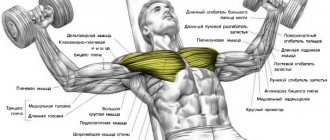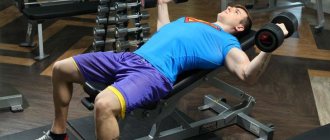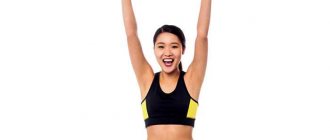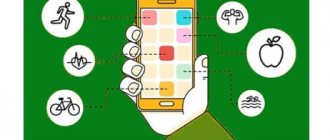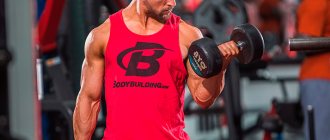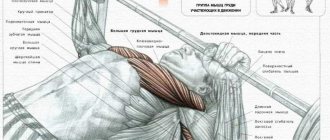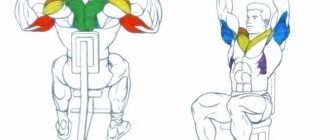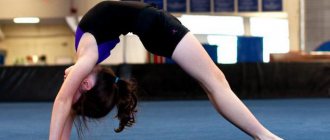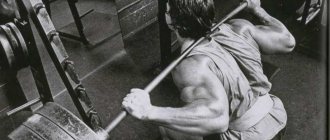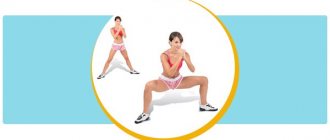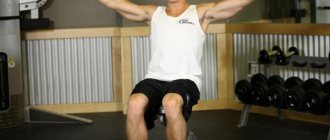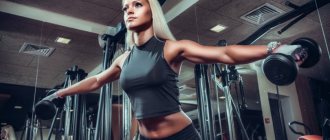Content
- 1 Features of performing arm raises with dumbbells
- 2 What muscles are involved?
- 3 Technique for performing arm raises with dumbbells 3.1 Allowed
- 3.2 Common mistakes
- 5.1 Performing seated dumbbell raises
Seated dumbbell raises
Sitting dumbbell raises
This is an anaerobic, single-joint, isolation, pulling exercise to target the middle deltoids. Designed for targeted development of the upper shoulder girdle. Recommended for keeping in shape volleyball players, weightlifters, handball players, gymnasts. Can be used as part of a split system to work out the upper shoulder girdle. Used as a supplement to basic exercises.
Analysis of the exercise
Anatomy of exercise - which muscles work
Advantages
Flaws
Preparation for execution
Carefully work out the joints involved by rotating in different directions and swinging your arms.
When the general warm-up is completed, move on to a special one - perform several sets of swings with light dumbbells (1-2 kg for women and 3-4 kg for men) to deeply warm up the ligaments and prepare the muscles.
Proper execution
Errors
Efficiency Tips
Inclusion in the program
The turn of raising dumbbells to the sides while standing comes at the very end of the delta training, when it becomes necessary to separately work out each beam separately after the basic exercises.
Following the standard scheme, perform the exercise for 12 repetitions in 3-4 approaches. A good return comes from combining swings on different deltoid heads within a triset.
Since we are talking about an isolated impact on small muscle “areas”, the weight will be limited by default. Only professional athletes can afford to use significant weights and “cheat”, but in doing so they usually have to sacrifice amplitude of movement. For an amateur, it is much more important to focus on the correct technique, which will allow you to accurately direct the load to the target area.
Contraindications
How to replace exercises
Technique for doing dumbbell raises
- Required level of training: beginner.
- Difficulty: medium.
- Tools: dumbbells, bench.
- Movement trajectory: ascent in a straight line without turning. When lifting, the arms are spread to the sides; when lowering, they are brought to the hips.
- at the lowest point: dumbbells parallel to the thighs. Forearms touch feet;
- at the top point: the two shoulders form a horizontal line.
Allowed
Muscles involved: 1 - deltoid; 2 - trapezoidal
- lifting dumbbells above the level of the shoulder joints;
- rest your back on the bench with an inclination angle of 90 degrees;
- performed by both sexes;
- Prohibited: performance in case of injuries to the upper shoulder girdle.
Common mistakes
- Straight arms overload the hands.
- Turning dumbbells increases the likelihood of injury and increases the load.
- Excess weight of the projectile increases the likelihood of injury and spoils the execution technique.
- Rocking the body eliminates the load and reduces efficiency.
Joints involved: shoulder blades, shoulder blades.
Preparation: Starting position sitting. The back is straight. Dumbbells in hands. Straight overhand grip. Hands down, elbows slightly bent. Legs are bent at an angle of 90 degrees.
Execution technique
Initial position:
- Take dumbbells of optimal weight in your hands and hold them on the sides of your hips with a neutral grip (alternatively, you can hold the weights in front of you or even behind you).
- Place your feet shoulder-width apart and bend your knees slightly.
- Lean forward slightly and tighten your abs.
Movement:
- As you exhale, keeping your body straight and your gaze directed forward, using the force of your middle deltoids, dynamically move the dumbbells along arcing paths strictly to the sides. At the very beginning of the movement, bend your elbows at a small, fixed angle.
- Stop the implements at the line where your shoulder is parallel to the floor.
- Perform a 1-2 second peak contraction hold at this point.
- Inhaling, slowly lower the projectiles to the starting position
Attention!
Recommendations!
Execution options!
Performing seated dumbbell flyes
Slow, without jerking or forcing. The body is motionless. Emphasis on the negative phase.
Step 1: Raise both arms simultaneously while exhaling. At the top point there is a pause. The angle at the elbows is maintained. The little fingers are held higher than the thumbs.
Step 2: Inhale and return to the starting position. No pause required.
Step 3: See Step 1.
Average number of approaches: 3. Average number of repetitions: 12.
Using a fitball instead of a bench puts stress on the core, increases the difficulty of the exercise, and requires stabilization of the body.
Dumbbell lateral raises
Dumbbell Lateral Raise
The Dumbbell Lateral Raise is an isolation exercise for the middle deltoids and will look good in any shoulder workout.
Muscles Worked The dumbbell lateral raise is an isolated exercise targeting the middle deltoids. With the correct technique, only these muscles work. For example, the barbell or dumbbell press is actually a basic exercise, since it involves a significant number of muscles, except for the deltoids. Raising dumbbells to the sides differs favorably in this regard.
Perform the exercise: Lifting dumbbells to the sides is done while standing. In the starting position, you stand straight, your arms are tense and lowered, squeezing dumbbells. Raising your arms should be done exclusively with the deltoids. The movement should be smooth and fast, no need to try to jerk. Your arms should be raised exactly until they are parallel to the floor. If you lift them higher, the trapezius muscles will come into play.
Although the exercise is called “dumbbell lateral raise,” you actually have to raise your arms forward and to the sides. They should be bent at the elbows to prevent injury to this joint. You shouldn’t chase weights: this is an isolated exercise; lifting large dumbbells simply won’t work. It’s better to do the exercise correctly and don’t try to help yourself with other muscles of the body.
The upward movement must be faster than the downward movement. At the top point, you can pause for a few seconds and then slowly lower your arms to the starting position. Raising your arms to the sides differs from most exercises in terms of breathing: at maximum effort (during lifting), you should not exhale, but take a deep breath. The arms drop as you exhale.
When should you do this exercise? Dumbbell lateral raises are a good way to end a shoulder workout. You shouldn’t do it at first; a military press or other barbell press variations are better for this. Although sometimes lifting dumbbells to the sides is performed at the beginning of a workout as a kind of warm-up.
Since this is an isolated exercise, the body recovers quickly after it. Experienced athletes can probably do it almost every workout, but this is unlikely to be necessary. This exercise should be performed no more than once a week.
Video “Lifting dumbbells to the sides”:
Previous
ShouldersSeated dumbbell press
Next
Shoulders Bent-over dumbbell lateral raises
Variations of arm extensions (incline)
Relieves stress from the back. Allows you to work on the deltoids in a concentrated manner. Gives additional stress to the deltoid muscles (posterior). Reduces the likelihood of execution technique errors.
Required level of training: intermediate.
Tools: dumbbells, bench.
The main load is on: deltoids (middle, rear).
Additional load on: trapezius, serratus anterior, triceps brachii.
Movement trajectory: ascent in a straight line without turning. When lifting, arms are spread apart, when lowering, they are brought together.
Joints involved: shoulder.
Raising arms (exercise)[edit | edit code]
Similar article:
Lying arm raises
Raising hands
belongs to the category of isolating exercises, since here only the shoulder joints are moved. As a result, many chest muscles are not worked. Unlike the bench press, which also stimulates the triceps, the fly indirectly targets only the anterior deltoids. The main work is performed by the pectoral muscles. The fly is considered a good exercise to complete a chest workout because it isolates and stretches them.
Raising straight arms with dumbbells to the shoulders, sitting in a forward bend[edit | edit code]
Raising straight arms with dumbbells to the shoulders, sitting in a forward bend
Characteristics
- Additional exercise
- Isolated/single-joint
- Traction
- Open circuit
- Intermediate and advanced levels of fitness
Stabilizing muscles
- Main muscles of the body.
- Shoulder joints: Rotator muscles.
- Shoulders: Serratus anterior, rhomboids, lower trapezius.
- Forearms: Wrist flexors.
Tips on proper exercise technique
:
- Do not use the force of inertia, especially lifting the body. Perform a slow, controlled movement through a full range of motion.
- Keep your chest and shoulders back. Lower your shoulder blades and move them outward.
- Doing the exercise with heavier weights and bending your arms at the elbow joints is “cheating.” By bending your elbows, you shorten the length of the effective lever, compensating for lifting the additional weight.
- Inhale as you move up.
Many training programs underestimate the importance of working the rear deltoid muscles. This exercise is ideal for inclusion in a training program in order to compensate for deficiencies in such exercises.
Brief description of the exercise
Keeping the angle of flexion in the elbow joints at 10-20°, raise your arms perpendicular to your body to shoulder level. Elbows should be higher than wrists. Lower your arms to the starting position and repeat the exercise.
Initial position
- Sitting on the edge of the bench.
- Place your feet behind your knees.
- With your hands down, hold them behind your shins.
| Motion Analysis | Joint 1 | Joint 2 |
| Joints | Brachial | Spatula |
| Directions of joint movements | Up - abduction in the horizontal plane Down - adduction in the horizontal plane | Up - adduction Down - abduction |
| Mobilizing muscles | Posterior deltoid muscle | Rhomboid muscles Trapezius muscles |
Technique: main rules
1) At the beginning of the exercise, be sure to slightly bend your elbows, this will relieve the stress on your elbow joints. However, do not bend too much, otherwise you will take the payload from the side delta.
2) When at the top point, the dumbbells are spread to the side, the elbows should look back, but in no case down. The elbow should be at the same level as the raised dumbbell, not below it.
3) Don’t slouch, no matter when you lift or lower dumbbells, keep your back straight and your chest slightly protruding forward.
4) You can perform cheating and help yourself by lightly swinging your torso and throwing up the weight with your legs, but this should only be done in the last 2-3 repetitions and in the last 1-2 sets of raising dumbbells to the sides.
5) Lower the dumbbells in front near the groin, and not on the sides of the body, this will stretch the side deltoids more strongly. When the dumbbells have dropped down, do not let them hit each other, this removes the load and sets the initial movement due to the dumbbells bouncing off each other, and you need not how easier, but how best to load the middle bundle of the deltoid muscle.
6) When raising the dumbbells, they should be strictly to the sides, do not push your arms forward, it’s easier to do this, but the load also goes from the middle section of the shoulder to the front deltoid.
7) It is necessary to lift the dumbbells slightly above the shoulders, if below the load the shoulders will not receive the full load, if above the trapezius will take part of the load.
To perform swings correctly, proceed as follows:
- Stand on a flat surface. Place your feet so that they are slightly wider than your shoulders, with your toes pointing out. Watch your back - it should be straight, slightly bend your torso forward. Bend your arms slightly at the elbow joint and lock them in this position. The average angle is 120 degrees. Do not raise your shoulders - they should be lowered throughout the entire exercise. Squeeze the dumbbells tightly (palms facing your hips). Make sure that they lightly touch your feet (no need to rest on them). Bend your knees slightly to maintain balance as you approach.
- As soon as the starting position is taken, begin moving the dumbbells to the sides. Make sure that your elbows do not move out of position. In the process of lifting a load, the little finger should be turned upward. As soon as the elbow joint has reached the level of the shoulder, you should lock in this position and, together with exhalation, lower your arms down to touch the thigh.
- Pay attention to your breathing. As you lower, smoothly release the air from your lungs, and after touching the dumbbells to your thigh, immediately begin a new cycle. Please note that the return movement of the hands is carried out slowly, with control of the load at each point. At this stage, many people try to bend their elbow joints - you should not do this.
- Try to keep your lower back tense and your torso straight.
The execution technique is correct if during the approach there is a feeling of the middle deltoid, and its stretching at the lowest point is physically felt. The effect is also visible visually - the muscle bundle becomes engorged with blood and begins to stand out from the rest of the groups. To improve the result and work the muscle of a particular arm, alternate execution is allowed. This option is also suitable for beginners who have not mastered the technique.
